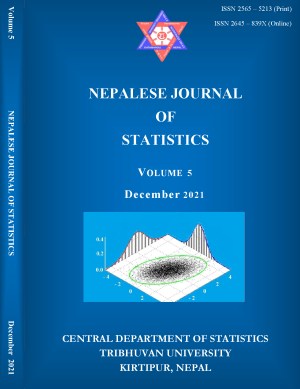Multinomial Logistic Regression Model for Assessing Factors Associated with Junk Food Consumption of Secondary Level Students
DOI:
https://doi.org/10.3126/njs.v5i1.41227Keywords:
Chi-square test, goodness of fit test, junk food consumption level, multinomial logistic regression, odds ratio, secondary level studentsAbstract
Background: Globalization, economic progress, urbanization, and industrialization have ushered in considerable changes in lifestyles and diet regimes. Consumption of junk food has surged at a rapid pace nowadays. In Nepal, there is a lack of sufficient research regarding junk food practices and persuading factors for its consumption, among teenage students. It is a global concern and has threatened the health of many people.
Objective: This research aims to explore the factors associated with junk food consumption among students of secondary level in Ratnanagar Municipality of Chitwan.
Materials and Methods: A cross-sectional research design consisting of 371 secondary level students, and selection based on primary data collection method by the researchers was used in this study. The data was analyzed using descriptive as well as an inferential statistical method. To find the association of different factors with junk food consumption levels (Low, Moderate, and High) multinomial logistic regression model (MLRM) was used, and the goodness of fit of the model was assessed.
Results: The fitted MLRM satisfied the criteria of the diagnostic test including a test of goodness of fit, multi-collinearity test, and minimum criteria of the model utilization with the classification accuracy of 55%. The variables like family monthly income (OR=1.000011, C.I=1.000001 - 1.000020), students’ daily pocket money (OR=1.02, C.I=1.007 - 1.033), gender (OR=0.354, C.I= 0.179 - 0.7), knowledge regarding junk food consumption (OR=2.744, C.I=1.366 - 5.511), attitude towards food choice (OR=2.487, C.I=1.288 – 4.803), friend’s encouragement for junk food consumption (OR=0.178, C.I=0.045 – 0.701), and occupation of father (business) (OR=2.867, C.I=1.084 – 7.581) are seen to be significant to the model High versus Low consumption. Students’ daily pocket money (OR=1.012, C.I=1.002 – 1.023), knowledge regarding junk food consumption (OR=2.427, C.I=1.293 – 4.553), restrictive food parenting practice (OR=2.228, C.I=0.945 – 5.253), friend’s encouragement for junk food consumption (OR=0.252, C.I=0.067 – 0.944), recognition of marketing promotion strategy (OR=0.523, C.I=0.295 – 0.928), educational level of mother (lower secondary level) (OR=5.465, C.I=1.069 – 27.952), occupation of father (business) (OR=2.47, C.I=1.056 – 5.777) are seen to be significant to the model Moderate versus Low consumption.
Conclusion: Study revealed that more than one-fourth of the sampled students were high consumers of junk foods. Many factors are associated with the consumption of junk foods. Thus, addressing the issue of increasing consumption, developing strategies & conducting different research in this field is the must. Concerned authorities should also pay special attention to this subject matter.
Downloads
Downloads
Published
How to Cite
Issue
Section
License
© Central Department of Statistics, Tribhuvan University, Kirtipur, Kathmandu, Nepal
The author of article must sign the copyright permission or the author must assign copyright to the Central Department of Statistics, Tribhuvan University prior to publication.
All rights reserved.




